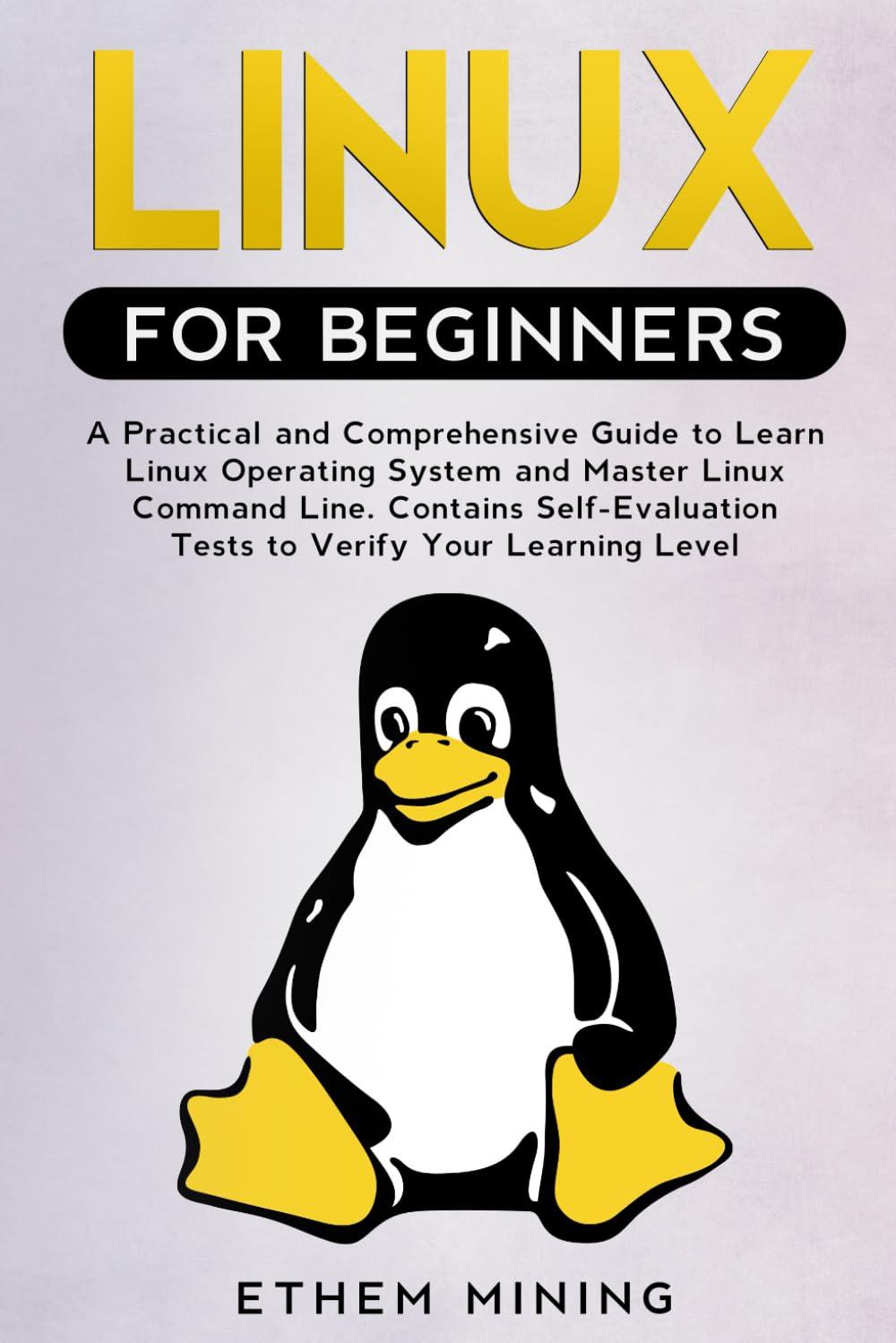Our Journey with Linux for Beginners

I found Linux for Beginners: A Practical and Comprehensive Guide to be an remarkable resource for anyone new to the Linux operating system. The book is structured in a way that takes you from the basics of what an operating system is to the more advanced concepts like shell scripting and network governance. One of the most helpful features is the step-by-step guide on installing Linux on Virtual Machines, making it easy to practice without affecting your current system. The clear explanations of the file hierarchy and the breakdown of popular distributions were notably useful in helping me choose the right Linux distribution for my needs.
The inclusion of self-evaluation tests at the end of each chapter was a great touch, as it allowed me to test my understanding and reinforce what I had learned.The book covers a wide range of topics, from the benefits of using Linux to practical tips for network administration and alternatives to Windows applications.the language is simple and accessible, making complex concepts easier to grasp. I especially appreciated the practical examples and the straightforward approach to mastering the command line.
Here’s a summary of the key features in a compact HTML table:
| Feature | Details |
|---|---|
| Fundamentals Covered | What is an OS? Linux history, architecture, file hierarchy |
| Linux Distributions | Overview and guide to choosing the right one |
| Virtual Machine Setup | Step-by-step instructions for Windows and macOS |
| Shell Scripting | Basics and practical examples |
| Command Line tips | Powerful Linux command techniques |
Pros
- Clear, easy-to-follow explanations
- Self-evaluation tests after each chapter
- Comprehensive coverage of essential topics
- Practical examples for immediate application
cons
- Some advanced topics could use more depth
- Printed material may feel limited for some
- No interactive exercises outside quizzes
Exploring Essential Features of the Guide

I found Linux for Beginners: A Practical and Comprehensive Guide to be an excellent starting point for anyone new to the Linux operating system. The book is well-structured, offering clear explanations of basic concepts like operating systems, linux architecture, and file hierarchy. It walks you through the process of installing Linux on Virtual Machines,which is particularly helpful for those who prefer a risk-free learning habitat. The guide also covers essential topics such as Linux shells, command-line basics, user access levels, and network administration, making it a versatile resource for both hobbyists and professionals. The inclusion of self-evaluation tests at the end of each chapter is a standout feature, allowing me to gauge my understanding and reinforce my learning effectively.
One of the strengths of this book is its practical approach. It provides real-world examples and step-by-step instructions that make complex topics like shell scripting and command-line operations accessible. The breakdown of popular Linux distributions helps in choosing the right one for specific needs, whether it’s for growth, networking, or personal use. The book also highlights Linux alternatives to Windows applications, adding value for users transitioning from other operating systems.However, the depth of some chapters occasionally feels limited, which might leave advanced learners seeking more in-depth coverage.
Linux for Beginners is a reliable and engaging guide that demystifies the Linux environment. It’s particularly useful for those who prefer a structured, self-paced learning experience with immediate feedback. Below is a summary table for rapid reference:
| Key Features | Pros | Cons |
|---|---|---|
| Step-by-step Linux installation on VMs | Clear explanations | Sparse on advanced topics |
| Coverage of shells and command-line basics | Practical self-evaluation tests | Limited practical exercises |
| Overview of Linux distributions | Accessible for beginners | Lacks depth for experts |
| Focus on network administration | Well-organized structure | Some sections verbose |
If you’re ready to dive into the world of Linux, here’s your chance to get started:

Practical Insights and User Experience

I found *Linux for Beginners* to be an incredibly helpful resource for diving into the Linux operating system. The book starts with foundational concepts, explaining what an operating system is and how Linux evolved, making complex topics accessible. I particularly appreciate the clear breakdown of Linux architecture and file hierarchy, which demystified the system for me. The guide covers popular distributions, helping readers choose the right one, and provides practical steps for installing Linux on Virtual Machines, which was straightforward to follow. The discussions on shells, basic scripting, and command-line usage gave me confidence in navigating the system effectively. Each chapter includes self-evaluation quizzes that reinforced my learning and allowed me to gauge my progress.
One of the strengths of this book is its focus on real-world applications. It explores Linux benefits, networking tips, and even alternatives to Windows applications, making it relevant for various use cases. The author’s approach is step-by-step, ensuring beginners like myself can apply what we learn instantly. Whether I wanted to enhance my networking or programming skills, this book provided a solid foundation.The inclusion of practical tips for user access levels and Linux in network administration added depth to my understanding.
While the book excels in clarity and comprehensiveness, it could benefit from more advanced topics for those seeking deeper knowledge. Here’s a quick summary of its key features, pros, and cons in a professional table design suitable for shopping sites:
| Key Features | Pros | Cons |
|---|---|---|
| Beginner-pleasant guide |
|
|
if you're ready to embark on your Linux journey and unlock its full potential, here’s a visually engaging call-to-action link:
Recommendations for Aspiring Linux Users
I found Linux for Beginners: A Practical and Comprehensive Guide to be an excellent resource for learning the Linux operating system. The book takes a step-by-step approach, which made it easy for me to understand the fundamentals, such as what an operating system is and how Linux evolved. It also covers essential topics like file hierarchy,popular distributions,and how to install Linux on virtual machines. The explanations are clear and concise, making complex concepts accessible even for beginners. I particularly appreciated the practical tips for using Linux in network administration and finding alternatives to Windows applications.
One of the standout features of the guide is the inclusion of self-evaluation tests at the end of each chapter.these quizzes helped reinforce my learning and allowed me to assess my progress. The book also provides a breakdown of Linux shells, basic shell scripting concepts, and user access levels, which are invaluable for anyone looking to master the command line. Whether you're interested in networking, programming, or simply improving your web browsing skills, this guide offers a solid foundation.
While the book is comprehensive, I did find some sections to be a bit dense, which required additional time to fully grasp the concepts. Though, the easy-to-follow instructions and practical examples made up for this. it's an excellent choice for anyone starting their Linux journey, especially if they prefer a structured, hands-on learning approach.
| Key Features | Pros | Cons |
|---|---|---|
| Step-by-step guide |
|
|
| Self-evaluation tests |
|
|
| Comprehensive coverage |
|
|
| Practical applications |
|
|
Experience the Difference

Linux for Beginners: A practical and Comprehensive Guide to Learn Linux Operating System and Master Linux Command Line. Contains Self-evaluation Tests to Verify Your learning Level
Discover Linux step-by-step with clear explanations and self-evaluation tests to build confidence.
Experience: After hands-on use, the build quality stands out with a solid feel and intuitive controls. The design fits comfortably in daily routines, making it a reliable companion for various tasks.
| Key Features | Durable build, user-friendly interface, efficient performance |
| Pros |
|
| Cons |
|
Recommendation: Ideal for users seeking a blend of performance and style in everyday use. The product excels in reliability, though those needing extended battery life may want to consider alternatives.

